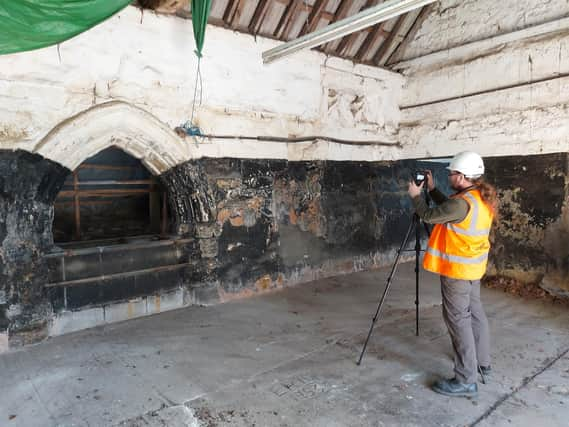New archaeological discoveries reveal secrets of 'enigmatic' Greasley Castle site


Archaeologists unearthed evidence that showed how Greasley Castle once rivalled Haddon Hall, the grand stately home in Derbyshire, in size and appearance.
Dr James Wright, of Triskele Heritage, who carried out the archaeological building survey, said: "Greasley Castle is an enigmatic site but the project has allowed us to understand this astonishing place for the first time.”
Advertisement
Hide AdAdvertisement
Hide AdThe castle, lying eight miles to the north-west of Nottingham near Watnall, was built in the mid-fourteenth century for the soldier and politician Nicholas de Cantelupe.
The survey shows that the site was a courtyard castle with corner turrets.
It had a fine great hall accessed via an impressive doorway. The room was illuminated by tracery windows flanking an early example of a recessed fireplace.
Fragments of stonework reveal that the decoration at the castle was magnificent and include carved head sculptures, moulded copings, and the crown of a vault.The castle was a prestigious building that allowed Cantelupe to display his power and status. In 1343, Cantelupe hosted the archbishop of York at Greasley, along with several other bishops, earls and knights, during a ceremony to found nearby Beauvale Priory.“The castle was very similar to Haddon Hall in Derbyshire,” said Wright.
Advertisement
Hide AdAdvertisement
Hide Ad“It was built around the same time and the layout of the great hall is comparable.
“The owners of castles were often inspired by one another’s buildings – although Greasley was slightly bigger than Haddon."
In 1485, Greasley was confiscated Henry VII after a later owner of the castle – John Lord Zouche – supported the doomed Richard III at the battle of Bosworth.
A century later, records show that the site had been turned into a farm.
Advertisement
Hide AdAdvertisement
Hide AdThe survey has been able to identify the remains of the castle survivingamong later farm buildings.The research was a standalone project but complements the plans of Greasley Castle Farm History Project to open a museum dedicated to the history of the site and local area, a tearoom, function room and workshops for local businesses.
The workshop space could also see a microbrewery, if plans are approved.
Sarah Seaton, historian and Project Manager for Greasley Castle and Manor Farms Project, said: “We really want this to be a community hub.
“It will be something affordable for local people. Firstly, we want to get the house renovated because the roof is quite badly worn.
Advertisement
Hide AdAdvertisement
Hide Ad“The initial idea was to have a tea room in the property and to have holiday lets above.
“We are also looking to turn the outbuildings into workshops for local artists and craftspeople who can rent them from us.
“There is nothing in the area that does anything like this.”
Council documents stated: “The farmhouse is currently underused and in need of repair.
“The proposed uses will also open the farmhouse to the public whilst providing a viable use to enable repairs.”